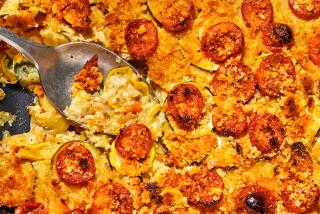The Case for Uncrisp Vegetables
- Share via
Although “baby” vegetables were once all the rage, cooking styles have changed in the past few years, and many cooks are remembering the charm of a long-cooked meal. And while baby vegetables are lovely when raw or quickly cooked, their lack of cellulose makes them too fragile for long, slow cooking, which requires mature vegetables whose cellulose, starches and sugars are fully developed.
These vegetables have to be cooked in ways that will break down their fiber and release their flavor.
* When making vegetable soup, for instance, cook green and other non-root vegetables to break down the cellulose walls so that the flavor of the vegetables is released. Root vegetables have a lot of sugar in them and must cook for a long time to release, and eventually to caramelize, their sugar.
* Another way of breaking down the cellulose of the long-cooked vegetable is sauteing. Vegetables high in cellulose and low in water content--such as broccoli, cauliflower and carrots--should be blanched (boiled quickly until barely tender) before sauteing. Don’t blanch softer vegetables like zucchini or eggplant. Do not crowd the skillet, or the escaping water will cause the vegetables to steam, not saute. Sauteed vegetables have a more intense taste than those that are boiled or steamed.
* Vegetables that are high in starch or sugar--root vegetables such as celeriac, parsnips, rutabagas, beets, turnips and carrots, or tubers such as potatoes, yams and Jerusalem artichokes--are the best to oven-roast. Oven-roasted vegetables can be cooked in the pan alongside roast meat, or they can be prepared separately. Lightly blanch the vegetable, toss with a little butter or oil and place in the pan to roast.
* Braised vegetables cook with just a little liquid and butter. In the process, they release a lot of their own juices, which are then reduced and concentrated. This is the best way of using all of the flavor in vegetables with a high water content, such as Belgian endive, celery and fennel.
* To gratinee vegetables, first braise them in cream and then finish them, often under the broiler, by quickly melting butter and cheese over the top to brown them. Many vegetables may be gratineed. The most common are either leafy vegetables such as celery, endive and lettuce, or starchy ones such as turnips and potatoes. The starchy ones require more liquid during cooking than the leafy vegetables.
* To glaze a vegetable, cook it in water or stock with butter--and sometimes with a little sugar--until the liquid is completely evaporated and forms a shiny coating. If you’re using sugar, it can be left “blond,” without color, or it can be cooked “brunette”--the caramelized sugar giving the vegetables a nice honey color. Glaze onions, carrots, turnips, Brussels sprouts and other vegetables that are not too soft and are sturdy enough not to fall apart.
MACARONI AND CHEESE WITH CAULIFLOWER
1/2 cup sun-dried tomatoes
Boiling water
1/4 cup butter or margarine
2 onions, coarsely diced
2 cups cauliflower florets
3 tablespoons flour
3 1/2 cups milk
Salt
1/2 teaspoon white pepper
3 bay leaves
1/4 teaspoon ground nutmeg
4 ounces Gouda cheese, shredded
12 ounces sharp Cheddar cheese, shredded
1/2 pound elbow macaroni
Place sun-dried tomatoes in bowl. Pour boiling water to cover tomatoes and let stand to soften 2 minutes. Drain and chop. Set aside.
Heat butter in large skillet. Add onions and cauliflower. Cover and cook, stirring, 5 minutes. Remove cover. Mix in flour and cook another minute. Add milk, 1/2 teaspoon salt, white pepper, bay leaves, nutmeg and dried tomatoes. Reduce heat to low. Cover and cook 10 minutes, stirring occasionally.
Meanwhile, cook macaroni in boiling salted water according to manufacturer’s direction. Drain and transfer macaroni to mixing bowl.
Remove bay leaves and pour contents of skillet over macaroni. Add Gouda and half Cheddar cheese. Mix well, then transfer contents to oven-proof casserole or baking dish. Bake, covered, at 350 degrees, 25 minutes. Remove cover. Sprinkle surface with remaining cheese and replace in oven another 10 minutes or until top browns lightly. Serve immediately. Makes 4 servings.


